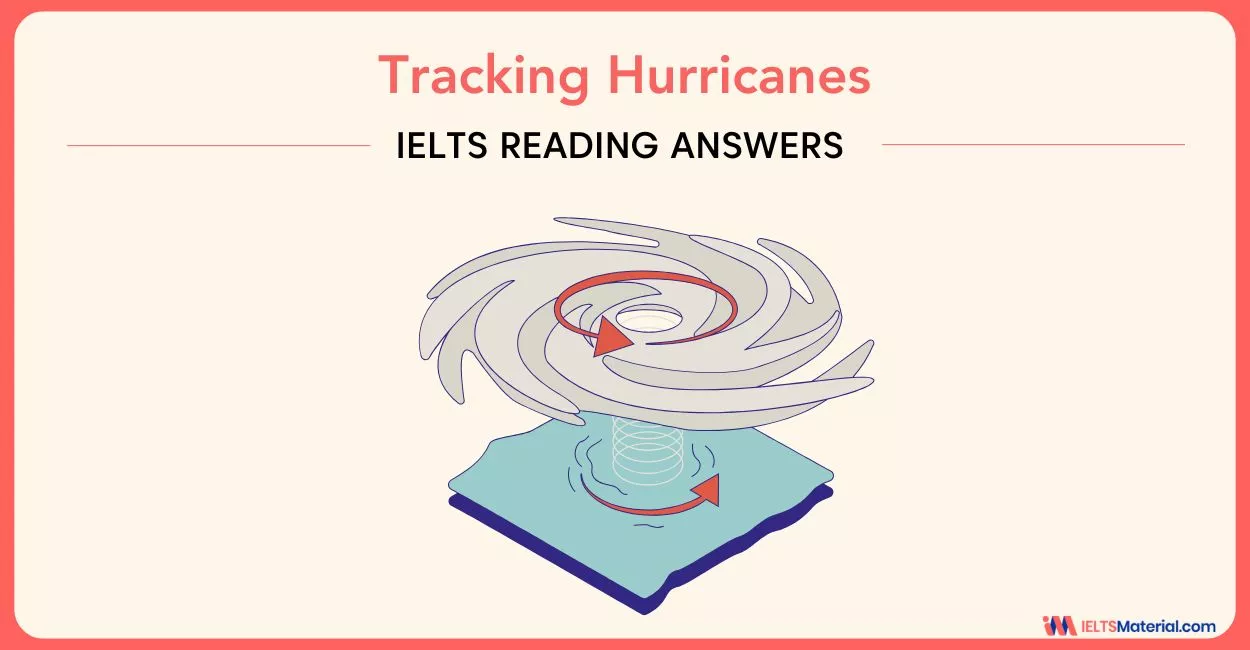Tracking Hurricanes - IELTS Reading Answers
12 min read
Updated On
-
Copy link
Get ready for IELTS Reading by solving the Tracking Hurricanes IELTS Reading Answers. Improve your score by mastering different question types & reviewing the provided answer explanations with location to test your reading skills for Band 9.
Table of Contents

Limited-Time Offer : Access a FREE 10-Day IELTS Study Plan!
In most cases, identifying the logical flow between the questions and the text can help you find answers more quickly and accurately in the IELTS Reading module. However, all you need to do is regularly practice passages from IELTS recent actual tests, like Tracking Hurricanes Reading Answers, and understand the areas for improvement.
In this blog, we will improve your performance in the reading module by checking your answers against the provided Tracking Hurricanes Reading Answers, explanations, and tips given here.
Questions & Passage for Tracking Hurricanes Reading Answers
By taking reading IELTS Academic Reading samples like Tracking Hurricanes IELTS Reading Answer, you can become familiar with the question styles presented to you as well as the level of challenge you should expect.
The Academic passage, Tracking Hurricanes Reading Answers, consists of 15 questions. It presents three different IELTS Reading question types. So, solving this passage will help you get acquainted with different IELTS Reading question types with examples.
The three question types in this reading passage include:
- IELTS Reading Short Answer Questions (Q. 1-4)
- IELTS Reading Table Completion (Q. 5-11)
- IELTS Reading Multiple Choice Questions (Q. 12-15)
Read the passage below and answer questions 1 – 15. Beyond the questions, you will find the answers along with the location of the answers in the passage and the keywords that help you find out the answers.
Tracking Hurricanes

Answers for Tracking Hurricanes IELTS Reading Passage with Location and Explanation
Check out the detailed explanations for the Tracking Hurricanes reading passage questions given above and get an idea of how to solve them and improve your reading skills for a top IELTS band score.
Unlock Answer
Signup/Login and get access to the answers
1 Answer: GPS-dropwindsondes
Question Type: Short Answer Question
Answer location: Paragraph A, line 1
Answer explanation: Paragraph A shares the fact that North American meteorologists from the National Oceanic and Atmospheric Administration (NOAA)’s Hurricane Research Division have recently ‘improved the success rate in their forecasting’ of where ‘hurricanes’ are likely to hit land by an estimated 15 to 30%. This ‘increase in accuracy is due’ to the use of instruments called GPS-dropwindsondes, which can probe the atmosphere surrounding a hurricane while it is still out at sea. Hence, the answer is GPS-dropwindsondes.
2 Answer: (weather) balloons
Question Type: Short Answer Question
Answer location: Paragraph A, line 3
Answer explanation: Paragraph A explains that the ‘atmospheric characteristics of hurricanes over land’ are well ‘understood’ because ‘an investigation’ is possible ‘with weather balloons containing sophisticated meteorological instruments’. When hurricanes are out of reach of balloons (at sea), gathering information is decidedly more difficult. Therefore, the reason for lack of knowledge of hurricanes at sea is that the balloons are not present there and it is away from its reach. Hence, the answer is ‘(weather) balloons’.
3 Answer: (the custom of) naming hurricanes began in the (early) 1950s
Question Type: Short Answer Question
Answer location: Paragraph B, line 3
Answer explanation: Paragraph B points out the fact that the ‘unnamed : Category 4 2 hurricane’, which struck south-east Florida in 1926 and killed 243 people would have caused an estimated $77 billion if it had struck today. This hurricane was unnamed because, according to the first footnote, ‘the custom of naming hurricanes began in the early 1950s’. Hence, the answer is (the custom of) naming hurricanes began in the (early) 1950s.
4 Answer: Camille
Question Type: Short Answer Question
Answer location: Paragraph C, line 2
Answer explanation: Footnote 2 mentions that hurricanes are categorised according to their wind speed from Category 1 (least intense) to Category 5 (most intense). Therefore, ‘Camille’, a Category 5 hurricane, mentioned in paragraph C, of such ‘catastrophic force’ that it caused over a billion and a half dollars worth of damage at the time and killed 256 people, struck the coast of the Gulf of Mexico in 1969 with winds over 320 km/h. Hence, the answer is Camille.
5 Answer: Hurricanes
Question Type: Table Completion
Answer location: Paragraph C, line 1
Answer explanation: Paragraph C states that ‘hurricanes’ occur in ‘cycles every few decades’, the ‘last intense period in the U.S. being from 1940 to 1969’. Hence, the answer is ‘hurricanes’.
6 Answer: heat (of water) / warm water
Question Type: Table Completion
Answer location: Paragraph C, last line
Answer explanation: Paragraph C points out that ‘hurricanes derive their energy’ from ‘the heat of warm water’, it is thought that an increase in the speed of the ‘Conveyor’, as it pulls warm water to the north, is an indicator of intensifying hurricane activity. Hence, the answer is heat (of water) / warm water.
7 Answer: (the) Atlantic Conveyor
Question Type: Table Completion
Answer location: Paragraph C, line 4
Answer explanation: Paragraph C informs that scientists do not know the precise reason for the cycles of hurricane activity, but they could be caused by a phenomenon called the ‘Atlantic Conveyor‘. This is the name given to the ‘gigantic current of water’ that ‘flows cold from’ the top of the globe slowly along the ‘Atlantic ocean floor (north) to Antarctica (south)’ and ‘resurfaces’ decades later before ‘flowing back north, absorbing heat as it crosses the equator’.Hence, the answer is (the) Atlantic Conveyor.
8 Answer: previously used sensors
Question Type: Table Completion
Answer location: Paragraph D, line 1
Answer explanation: Paragraph D notes that the use of GPS-dropwindsondes began in 1997. Small sensing devices dropped from planes at very high altitudes and over a wide area, they are ‘far more revealing than’ (the new sensors offer more information) ‘previously used sensors’. Hence, the answer is previously used sensors.
9 Answer: data analysts
Question Type: Table Completion
Answer location: Paragraph E, line 2
Answer explanation: Paragraph E tells us data analysts have discovered a greater variability in the winds (now) at sea level than previously believed (knew before), but many forecasting problems are beyond a solution, at least for the time being. Hence, the answer is data analysts.
10 Answer: (a) computer (simulation) / hurricane researchers
Question Type: Table Completion
Answer location: Paragraph F, line 2
Answer explanation: It is given in paragraph F that one surprising result of a recent ‘computer simulation’ was the ‘destruction of a large part of downtown New York’. ‘Hurricane researchers’ believe that the ‘city is more likely than Miami to suffer a direct hit in the near future’. Hence, the answer is computer (simulation) / hurricane researchers.
11 Answer: (a) storm surge
Question Type: Table Completion
Answer location: Paragraph F, line 3
Answer explanation: Paragraph F relates that certain geographical features of the coastline near New York make it conceivable that a ‘wall of water’ (huge wave of water) called a ‘storm surge’ ‘pushed ashore’ (blown on land) ‘by hurricane winds’ would cause a devastating flooding of Manhattan. Hence, the answer is (a) storm surge.
12 Answer: D
Question Type: Multiple Choice Questions
Answer location: Paragraph D, line 2
Answer explanation: Paragraph D explains the use of GPS-dropwindsondes which began in 1997. Small sensing devices dropped from planes at very high altitudes and over a wide area, they are far more revealing than previously used sensors. Because they ‘weigh only 0.4 kilograms’, they are ‘able to stay aloft for longer periods’ and ‘broadcast more data to the ground’. Each sonde carries its own ‘global positioning satellite receiver’ (GPS). The ‘GPS signals received are used to calculate the direction and speed of the wind, and data on temperature, humidity, and barometric pressure at half second intervals all the way down to the ocean surface’. Hence, the answer is D (can be more accurately measured by satellite assistance).
13 Answer: D
Question Type: Multiple Choice Questions
Answer location: Paragraph B, line 3
Answer explanation: In paragraph B, the writer writes ‘Category 4 2 hurricane’ (not as intense as hurricane Camille, a Category 5 most catastrophic hurricane), which ‘struck south-east Florida in 1926’ and killed 243 people ‘would have caused an estimated $77 billion if it had struck today’ (it did not cause but might have caused in present-day). The reason for this is the ‘explosion in population growth and development’ (it is the reason for so much destruction by hurricanes at present times) along the southeast coast of the U.S. during the last half-century. Hence, the answer is D (none of the above).
14 Answer: B
Question Type: Multiple Choice Questions
Answer location: Paragraph C, line 2
Answer explanation: Paragraph C states that Camille’, a ‘Category 5 hurricane of such catastrophic force’ (U.S. worst hurricane of the 20th century) that it ‘caused over a billion and a half dollars worth of damage at the time’ (it is the value in 1969, not today) and ‘killed 256 people’ (in terms of life lost), struck the coast of the Gulf of Mexico in 1969 with winds over 320 km/h. Hence, the answer is B (was the worst U.S. storm this century in terms of life lost).
15 Answer: A
Question Type: Multiple Choice Questions
Answer location: Paragraph F, last line
Answer explanation: Paragraph F brings out that one surprising ‘result of a recent computer simulation was the destruction of a large part of downtown New York’. A storm surge was responsible for the more than 8000 deaths caused by the hurricane that destroyed the city of Galveston in 1900. Therefore, option B does not fit in because computer simulations are used to predict storm surges and the latter is not in control of the former. In paragraph D, it is given that the GPS signals (computer predictions) received are used to calculate the direction and speed of the wind, and data on temperature, humidity, and barometric pressure at half second intervals all the way down to the ocean surface. This helps to forecast hurricanes. So, even Option C is untrue. In paragraph C, the writer introduces the concept of a phenomenon called the ‘Atlantic Conveyor’. This is the name given to the gigantic current of water that flows cold from the top of the globe slowly along the Atlantic ocean floor to Antarctica and resurfaces decades later before flowing back north, absorbing heat as it crosses the equator. So, from this, it can be inferred that hurricanes occur in many parts of the world. Thus, option D is incorrect Hence, the answer is A (accurate tracking of hurricanes might be possible in the future).
Master Academic Reading with our IELTS Reading guide for high scores on reading passages!
Tips for Answering the Question Types in Tracking Hurricanes Reading Answers
Now let’s go through the IELTS exam preparation tips for band score of 8+ for each question type in the Tracking Hurricanes Reading Answers. It will help you understand how to approach the problem of each question type.
Short Answer Questions
You will have to take words from the given text to write the short answers.
- Go through the instruction: It is important to pay close attention to the instructions that are given in the question because in some instructions there will be a word limit mentioned and you may lose marks if you don’t follow it.
- Understand the question: Look for what type of information is required: person, place, number, date, reason, etc.
- Locate the keyword/s: Once you have gone through the questions, you should note down the keywords to find the answer when you go through the passage.
- Scan, do not skim: Quickly locate the section of the passage where the answer must be found.
- Use synonyms and paraphrases: The question rarely uses the same words as the text. So, be careful and do not waste time looking for the same words.
- Answer directly, not in full sentences: Keep it concise; only write the required words.
Table Completion
In the table completion questions, you will be asked to complete a set of tables based on the information given in the text. The question will be to write an answer (fill in the blank in the table) from the text given. Usually, these kinds of questions will only be based on one part of the passage, so you won’t have to read the whole passage to fill in the important information.
- Notice the categories: Tables usually show comparisons, causes/effects, or timelines. Identify the pattern before filling.
- Follow logical order: Information in the passage usually follows the same sequence as in the table.
- Keep grammar consistency: Make sure the filled-in word/phrase matches the grammatical form of the row/column.
- Use exact words from the passage: Unlike Short Answer Questions, you must copy words exactly (spelling counts).
- Pay attention to numbers and units: Do not drop ‘km’, ‘%’, or ‘million’ if they are part of the answer.
Multiple Choice Questions
It requires you to select the correct answer from a list of options. There are various numbers of answer options, but test takers can usually expect to choose from three or four options, all of which are letters (A, B, C, or D). The type of question requires test takers to select one out of the four alternatives, but you may also have to select two answers from five possibilities or three responses from six options.
- Read the question first, not the options: Understand what is being asked before looking at choices.
- Scan for the correct passage section: MCQ answers usually appear in order in the text.
- Eliminate distractors: Cross out answers that are too broad, opposite, or irrelevant.
- Watch out for paraphrasing: The correct option often rephrases the passage rather than copying it.
- Do not rush if two seem correct: Re-read carefully. One option will be slightly more precise than the other.
To conclude, we have explored the Tracking Hurricanes Reading Answers with location and various IELTS Reading tips and techniques to increase your reading speed to help you confidently tackle those challenging questions. However, you should keep practicing with different IELTS Reading tests. If you need guidance while working through these passages, you can chat with an IELTS expert or attend our free IELTS online webinars to improve your weak areas on the IELTS reading exam.
Check More IELTS Reading Answers:
Practice IELTS Reading based on question types

Start Preparing for IELTS: Get Your 10-Day Study Plan Today!
Explore other Reading Practice Tests

Kasturika Samanta

Kasturika Samanta

Nehasri Ravishenbagam
Recent Articles

Nehasri Ravishenbagam

Haniya Yashfeen

Haniya Yashfeen

Haniya Yashfeen





Post your Comments